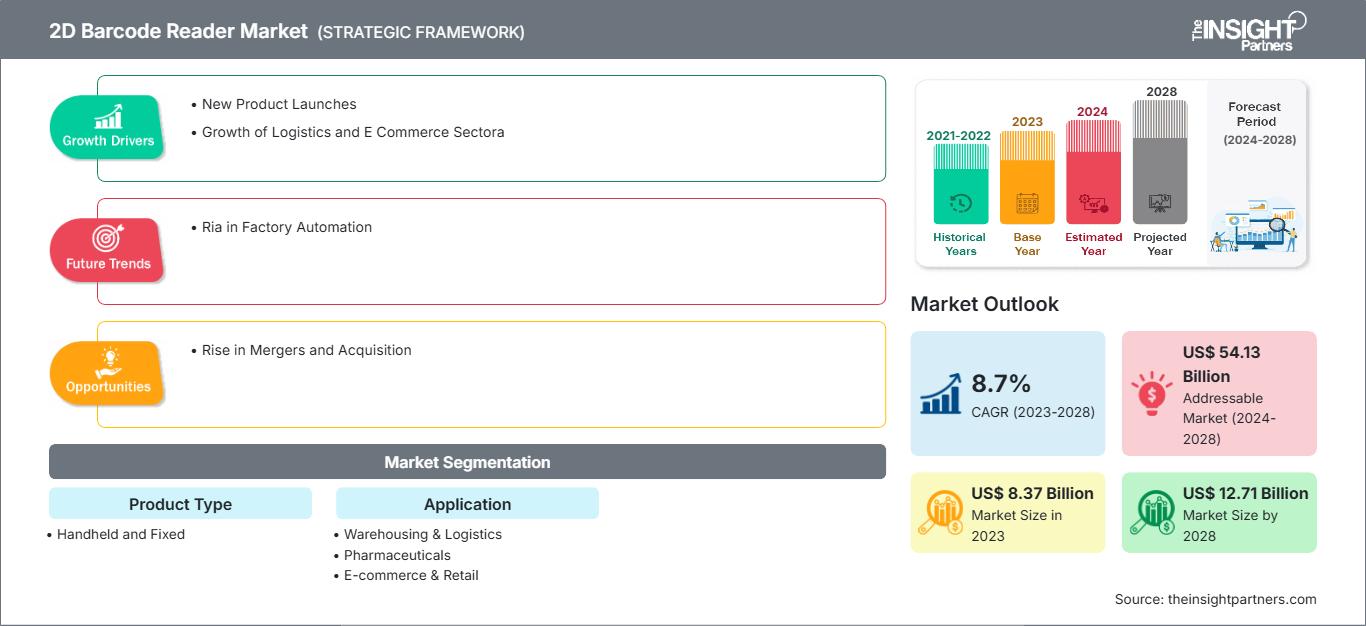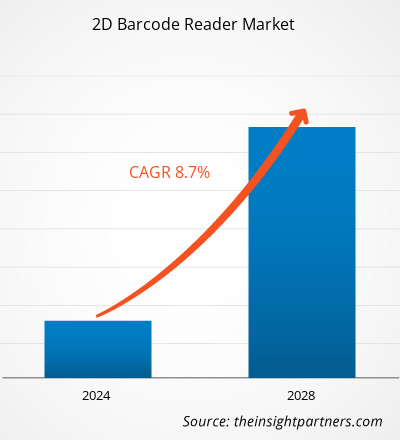[연구 보고서] 2D 바코드 리더기 시장은 2023년 83억 7,312만 달러에서 2028년 127억 870만 달러로 성장할 것으로 전망되며, 2023년부터 2028년까지 연평균 8.7% 성장할 것으로 예상됩니다.
공장 자동화는 생산량 증대 및 인건비 절감을 위해 제조 공정을 자동화하는 기술과 기계를 도입하는 것입니다. 또한 인적 오류 위험을 최소화하여 제품 품질을 향상시키는 데에도 도움이 됩니다. 따라서 시장 참여자들은 2D 바코드 리더기 시장 트렌드로 여겨지는 공장 자동화 도입을 점차 확대하고 있습니다. 예를 들어, 자동차 기술 회사인 라미나(Laminar)는 2023년 4월, 새롭게 개발된 자동화 공장에서 사업을 시작했습니다. 공장 자동화는 센서 생산량 증가에 기여할 것입니다. 또한, 2022년 11월, 전기차(EV) 스타트업 "Weber Drivetrain"이 인도 푸네에 EV 부품 생산을 위한 자동화 시설을 개장했습니다. 이 시설은 세미 로봇과 기계류로 구성되어 있습니다. 이러한 사례는 다른 시장 참여자들이 시설 자동화를 통해 생산량을 늘리도록 장려할 것입니다. 자동화 공장에서는 제품 추적 및 식별 기능을 향상시키기 위해 2D 바코드 리더를 점점 더 많이 사용하고 있습니다. 이 리더는 수동 제품 추적보다 정확한 제품 정보를 제공합니다. 또한, 생산 속도를 높이고 제품 고유 코드를 활용하여 제품의 제조 날짜 및 배치 번호 정보를 추적합니다. 이 정보는 운영자가 제품의 실시간 정보에 지속적으로 접근할 수 있도록 하여 비즈니스 프로세스를 더욱 효율적으로 관리하는 데 도움이 됩니다. 따라서 예측 기간 동안 공장 자동화의 증가는 2D 바코드 리더 시장 트렌드가 될 것으로 예상됩니다.
요구 사항에 맞게 이 보고서를 사용자 정의하십시오.
이 보고서의 일부, 국가 수준 분석, Excel 데이터 팩을 포함하여 모든 보고서에 대한 사용자 정의를 무료로 받을 수 있을 뿐만 아니라 스타트업 및 대학을 위한 훌륭한 제안 및 할인을 이용할 수 있습니다
2D 바코드 리더 시장: 전략적 통찰력

-
이 보고서의 주요 주요 시장 동향을 확인하세요.이 무료 샘플에는 시장 동향부터 추정 및 예측에 이르기까지 데이터 분석이 포함됩니다.
미국, 캐나다, 멕시코는 북미의 주요 국가입니다. 끊임없이 발전하는 제조업은 이 지역이 기술 개발의 중심지이기 때문에 번영, 일자리, 그리고 혁신을 이끄는 주요 요인입니다. 2021년 1월, 미국 대통령은 기술적으로 진보되고 자동화된 제조 부문 구축에 중점을 둔 "Made in America" 이니셔티브를 통해 미국 제조업 부문 강화 계획을 발표했습니다. 이 이니셔티브에 따라, 미국의 생산량 증대를 위한 R&D 및 첨단 기술 도입에 3,000억 달러를 투자했습니다. 이러한 기술 발전과 자동화는 미국 경제의 촉매제 역할을 할 수 있습니다. 따라서 이 지역 제조업 부문의 자동화 증가는 2D 바코드 판독기 수요를 증가시키고, 수동 작업을 대체하는 기계 및 시스템 사용도 급증할 것으로 예상됩니다. 2D 바코드 판독기는 제조 공정 전반에 걸쳐 제품 정보를 추적하는 데 도움을 주어 제조 부문의 수요를 촉진하고 북미 2D 바코드 판독기 시장 성장을 촉진합니다.
COVID-19 팬데믹은 전 세계 전자상거래 부문에 긍정적인 영향을 미쳤습니다. COVID-19 팬데믹 기간 동안 온라인 쇼핑 플랫폼의 급증으로 인해 미국과 캐나다의 전자상거래 매출은 2020년에 상당한 성장을 기록했습니다. 같은 해, 쇼핑객들은 건강 및 위생 제품, 의약품, 손 소독제 등 다양한 제품을 구매하기 위해 온라인 플랫폼으로 이동했습니다. 따라서 바코드가 배송 및 분류 시스템에 사용됨에 따라 전자상거래에서 2D 바코드 스캐너에 대한 수요가 증가했습니다. 팬데믹은 미국과 캐나다 등 여러 국가에서 전자상거래의 급격한 성장을 가져왔으며, 전자상거래에서 2D 바코드 판독기 생산량도 증가했습니다. 여러 국가에서 전자상거래 거래의 일부가 고급 제품 스캔에서 생필품 스캔으로 전환되었습니다. 따라서 2D 바코드 판독기의 적용 분야도 증가했습니다. 이는 2D 바코드 리더 시장의 성장에 기여했습니다.
시장 분석 - 2D 바코드 리더 시장
응용 분야를 기준으로 전 세계 2D 바코드 리더 시장 규모는 창고 및 물류, 제약, 전자상거래 및 소매 등으로 구분됩니다. 2D 바코드 리더는 제약 산업의 필수적인 부분입니다. 2D 바코드 리더는 제품을 정확하게 추적하고 정확하고 완전한 백신 및 의약품 재고 데이터를 수집할 수 있도록 지원합니다. 특히 GS1-Datamatrix를 포함한 2D 바코드는 제약 산업의 전자 제품 코딩 표준으로 자리 잡았습니다. 이러한 스캐너는 약국 결제 및 약국 의약품 검증에 사용됩니다. 약국에서는 2D 바코드 리더를 사용하여 의약품 및 기타 의료 제품을 스캔하여 예방 접종 기록의 데이터 품질을 향상시킵니다. 2D 바코드를 사용하면 약국의 데이터 품질을 향상시킬 수 있습니다. 예를 들어, ISafe Mobile은 2021년 4월, 스마트폰이 통합된 다기능 핸드헬드 바코드 스캐너 IS-TH1XX.1을 출시하여 제약 산업을 타깃으로 삼았습니다. 이 바코드 리더기를 사용하면 약사가 2D 바코드를 스캔하여 모든 중요 데이터를 재고 기록에 입력할 수 있습니다. Zebra Technologies Corp, Cognex Corporation, Honeywell International Inc, CILICO는 제약 산업에 2D 바코드 리더기를 공급하는 주요 업체입니다.
2D 바코드 리더기 시장 규모는 제품 유형, 애플리케이션 및 지역을 기준으로 세분화됩니다. 제품 유형별로 2D 바코드 리더기 시장은 핸드헬드와 고정형으로 분류됩니다. 유형별로는 창고 및 물류, 제약, 전자상거래 및 소매 등으로 세분화됩니다. 지역별로는 북미, 유럽, 아시아 태평양(APAC), 중동 및 기타 지역으로 세분화됩니다. 아프리카(MEA) 및 남미(SAM)
2D 바코드 리더 시장The Insight Partners의 분석가들은 예측 기간 동안 2D 바코드 리더 시장에 영향을 미치는 지역별 동향과 요인을 면밀히 분석했습니다. 이 섹션에서는 북미, 유럽, 아시아 태평양, 중동 및 아프리카, 그리고 중남미 지역의 2D 바코드 리더 시장 부문 및 지역별 분포도 살펴봅니다.
2D 바코드 리더 시장 보고서 범위
| 보고서 속성 | 세부 |
|---|---|
| 시장 규모 2023 | US$ 8.37 Billion |
| 시장규모별 2028 | US$ 12.71 Billion |
| 글로벌 CAGR (2023 - 2028) | 8.7% |
| 이전 데이터 | 2021-2022 |
| 예측 기간 | 2024-2028 |
| 다루는 세그먼트 |
By 제품 유형
|
| 포함된 지역 및 국가 |
북미
|
| 시장 선도 기업 및 주요 회사 프로필 |
|
2D 바코드 리더기 시장 참여자 밀도: 비즈니스 역학에 미치는 영향 이해
2D 바코드 리더 시장은 소비자 선호도 변화, 기술 발전, 그리고 제품 이점에 대한 인식 제고 등의 요인으로 인한 최종 사용자 수요 증가에 힘입어 빠르게 성장하고 있습니다. 수요가 증가함에 따라 기업들은 제품 라인업을 확장하고, 소비자 니즈를 충족하기 위한 혁신을 추진하며, 새로운 트렌드를 적극 활용하고 있으며, 이는 시장 성장을 더욱 가속화하고 있습니다.

- 을 얻으세요 2D 바코드 리더 시장 주요 주요 플레이어 개요
Adesso Inc, Cognex Corp, Newland Auto-ID Tech Co Ltd, Honeywell International Inc, Keyence Corp, OMRON Corp, Guangzhou Netum Electronic Technology Co Ltd, Datalogic SpA, Zebex Industries Inc, Zebra Technologies Corp.는 시장 조사 기간 동안 2D 바코드 판독기 시장의 주요 기업으로 선정되었습니다. 이 시장 조사 기간 동안 이러한 기업 외에도 여러 주요 기업을 조사 및 분석하여 글로벌 2D 바코드 판독기 시장에 대한 전체적인 개요를 파악했습니다.
2D 바코드 판독기 시장 참여자들은 주로 고객 가치 창출을 위한 맞춤형 솔루션에 중점을 둡니다.
- 2023년 1월, Cognex는 물류 터널용 DataMan 580 고정형 바코드 판독기를 설계했습니다. 이 회사는 고속 운영과 향상된 추적성을 자랑합니다.
- 2023년 1월, Adesso는 이탈리아 소프트웨어 회사인 WebScience를 인수했습니다. 이는 이탈리아 시장에서의 입지를 강화하기 위한 전략적 조치입니다. 이번 인수를 통해 Adesso는 소프트웨어 솔루션 포트폴리오를 확장하고 이탈리아 고객에게 맞춤형 서비스를 제공하는 역량을 향상시킬 수 있게 되었습니다.
- 과거 분석(2년), 기준 연도, CAGR을 포함한 예측(7년)
- PEST 및 SWOT 분석
- 시장 규모 가치/거래량 - 글로벌, 지역, 국가
- 산업 및 경쟁 환경
- Excel 데이터세트
최근 보고서
사용 후기
구매 이유
- 정보에 기반한 의사 결정
- 시장 역학 이해
- 경쟁 분석
- 고객 인사이트
- 시장 예측
- 위험 완화
- 전략 기획
- 투자 타당성 분석
- 신흥 시장 파악
- 마케팅 전략 강화
- 운영 효율성 향상
- 규제 동향에 발맞춰 대응






















 무료 샘플 받기 - 2D 바코드 리더 시장
무료 샘플 받기 - 2D 바코드 리더 시장